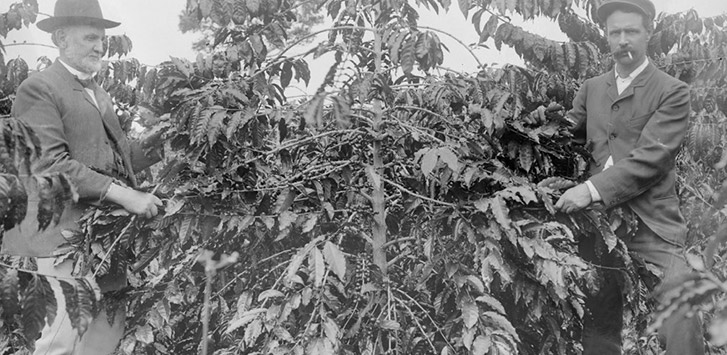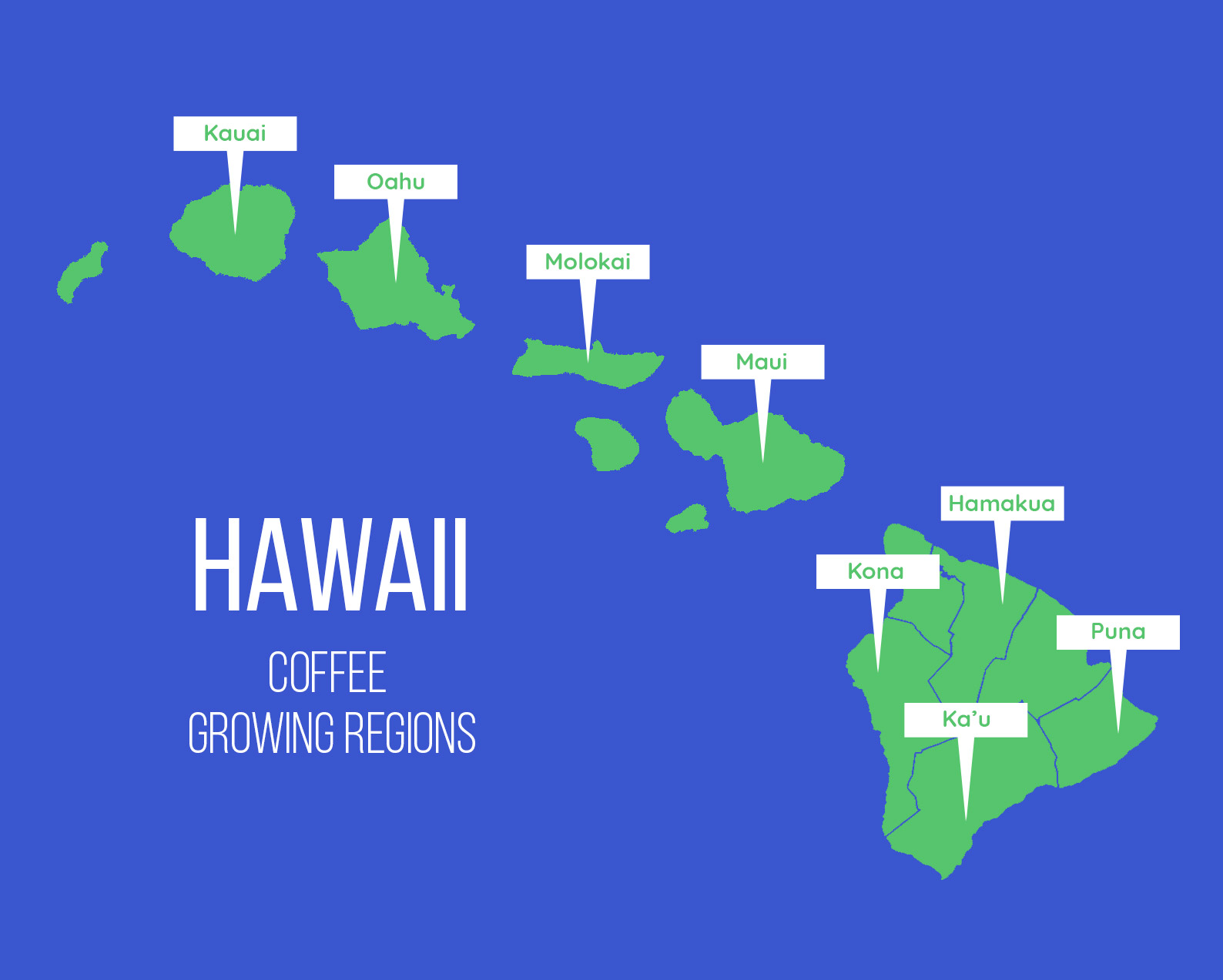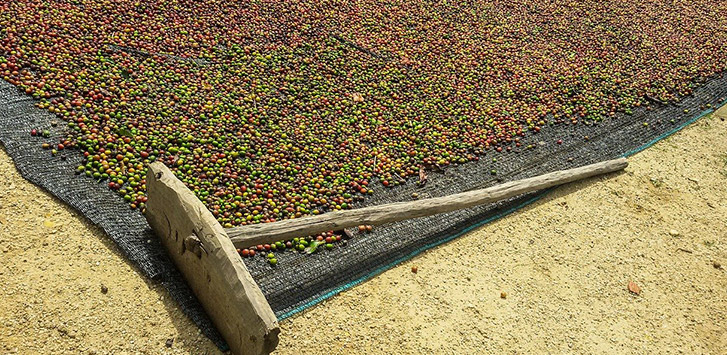
Hawaiian coffee, the only coffee grown in America, makes up 0.03% of the world’s coffee, but what it lacks in quantity, it makes up for in quality. Catering to tourists, Hawaiian coffee sells for a steep price. The popular Kona coffee beans are well-known for its smooth acidity, syrupy mouthfeel, and well-rounded flavor profile.
History

Like so many other coffee-producing countries, coffee isn’t native to Hawaii. Don Francisco de Paula Marin brought coffee to Hawaii in 1817, but his crops quickly failed. The first successful crop was planted by Chief Boki, the governor of Oahu, in 1825. He planted Brazilian coffee beans in the Manoa Valley. Within a couple years, coffee farming spread throughout all of Hawaii’s islands.
In 1828, Samuel Ruggles, a missionary, took seeds from the Hilo area and planted them in the Kona region, eventually introducing the Bourbon variety, Kanaka Kopi, to the Big Island. Herman Weidemann had the greatest impact on the Hawaiian coffee industry. In 1892, he introduced the Guatemalan Typica variety.
It soon became apparent that the Guatemalan variety grew better than the variety Ruggles had planted in Kona, causing many farmers in the Kona area to adopt the Guatemalan variety. They changed the name to Kona Typica in the 1990s to avoid confusion with Guatemalan coffee.
In the 1980s, sugarcane ceased to be profitable for Hawaii, so farmers turned to coffee, bringing about a resurgence of the coffee industry in Hawaii. The industry quickly grew from this point on, harvesting 2.8 million pounds in 1990 and 10 million in 1999.
Like every other coffee growing country, though, Hawaii has experienced setbacks. Within the past decade, droughts and the coffee borer (a tiny beetle that digs into the coffee cherries), have damaged the industry.
Growing Regions & Cultivation

Hawaiian coffee is grown in 11 major regions in 5 different states: Kona, Ka’u, Puna, Hamakua, Kauai, Maui, Molokai, and Oahu.
Kona: Located on the Big Island, this area is often referred to as the Kona coffee belt because of the number of farms located in the 30 miles long and 2-mile-wide strip of land.
Kona coffee is well-known for its variety and complexity, due to the numerous micro-climates and volcanic soil in the region. Kona beans grown at 1200 ft. elevation create a mellow, subtle, and delicately balanced, sweet flavorful coffee with notes of chocolate. Kona that's grown at elevations closer to 1600 ft. are defined by floral characteristics and rich sugars, rounded out with a silken body and deep fruity notes.
When buying Kona beans, make sure you buy 100% Kona coffee to fully experience the nuanced flavors. Kona blends only consist of 10% Kona, which means the Kona’s characteristics are hidden by the other 90% of the blend.
Ka’u: Located on the southern slope of the Mauna Loa volcano, Ka’u coffee grows in similar conditions to the Kona variety. Converted from a sugarcane plantation in 1996, the coffee grown here is richly nuanced with a syrupy mouthfeel, complex acidity, and tasting notes of malt, citrus, berries, brown sugar, and vanilla.
Puna: As the wettest region on the Big Island, Puna’s cold, cloudy climate is one of the most untapped potential growing regions. Here, the coffee is grown either above lava or in the lava. The sulfur cultivates a highly aromatic and acidic coffee with a syrupy body and notes of sandalwood, cacao nib, grapefruit, and deep chocolate. If the coffee is roasted correctly, the high acidity can create greater dimension with flavors like orange blossom, red wine, and sour apple.
Hamakua: This region boasts the most fertile soil on the Big Island. Most farms in the area are small, family-run businesses where they hand pick the coffee cherries, resulting in a higher quality product. The coffee from this area has a smooth, round mouthfeel with low acidity and notes of rich, baker’s chocolate and nuts.
Kauai: Historically, Hawaii’s first commercial coffee growing operation was located in Kauai. Now, it’s home to the largest coffee farm in Hawaii. The climate is great for growing coffee with consistent sunshine, mild nights, and abundant rainfall. This coffee is mellow and delicate with a mild acidity that allows for greater flavor development than some Kona varieties, increasing its popularity.
Maui: Formerly dedicated to sugarcane, coffee has taken over this mountainous area. These farmers are more experimental with their crops, using different harvesting tools, processing techniques, and bean varieties. The wetness of the land and micro-climates create a coffee bean that’s similar to the Kona – clean and bright with hints of brown sugar, milk chocolate, citrus, and berry.
Molokai: A single plantation rests on this island off the west coast of Maui. The red volcanic soil crafts a more pronounced flavor with a rich body and mild acidity. Sweet, nutty tones are woven throughout this red catuai arabica varietal.
Oahu: Oahu’s one coffee farm, Waialua Estate, sits in the north about 600-700ft. above sea level. The coffee beans that are grown here produce smooth, mellow, well-balanced, and medium-bodied coffee.
Growing Conditions
Overall, the growing conditions in Hawaii are ideal for coffee. The volcanic soil, the ratio of sunshine to shade, abundance of rain, mild winds, and cool nights with higher elevation form the perfect conditions for great coffee beans.
Cultivation
Hawaiian coffee plants bloom between February and March and are harvested between August and January. The coffee cherries then undergo wet milling to separate the pulp from the bean.

Once completed, the beans are fermented for 12 hours (if grown at 1600ft. elevation) or 24 hours (if grown at 1200ft. elevation). After fermentation, they are dried and then dry milled to separate the parchment-like skin from the bean. From here, the beans are roasted, bagged, and shipped off!
When buying Hawaiian coffee, you can expect to pay $20 to $50 per pound. Since Hawaii is part of America, Hawaiian coffee workers are paid minimum wage, compared to the $2-$3/hour that many other countries pay their coffee workers.
With the increase in pay and the emphasis on quality and fair trade, Hawaiian coffee beans have become one of the most expensive, but well worth it, coffees out there.
Flavor Profile
Hawaiian coffee beans boast numerous flavor profiles, due to the varying climates of each region, but there are some common characteristics. Hawaiian coffee is bright, clean, and crisp with a smooth, syrupy mouthfeel. The most common tasting notes are milk chocolate, brown sugar, molasses, and honey. Some other varieties include floral notes, orange, and blackberry.
Roasting Suggestions
Hawaiian coffee does well with many different roasts, but a medium roast is often best. Lighter roasts emphasize all the nuanced, natural flavors, while darker roasts tend to dampen the flavor profile, as the moisture and oil are extracted from the bean.
Brewing Methods
Hawaiian coffee beans range from mildly acidic to highly acidic, which impacts the type of brewing method that you should use.
With a mildly acidic varietal, the French Press method is great. The ensuing coffee is smooth, well-rounded, full-bodied, and sweet. The French Press works best with a medium to medium-dark roast since it’s able to highlight the natural full body and flavor profile. Lighter roasts can be too weak for a French Press and often turn sour.
With a more acidic varietal, a drip coffee machine works well. It maintains the balance of body, acidity, and sweetness while highlighting the flavors.
Hawaiian coffee is more of an investment than other coffees, but it’s well worth it. With the attention to quality and the natural, nuanced flavors, it’s hard to beat a good ol’ cup of Hawaiian coffee.